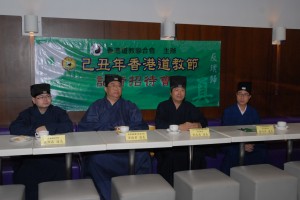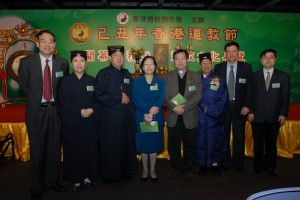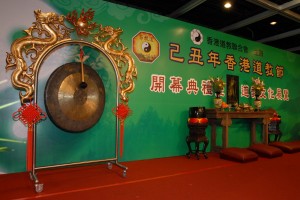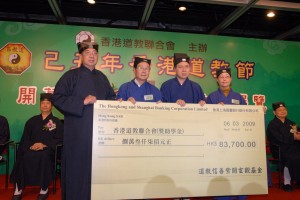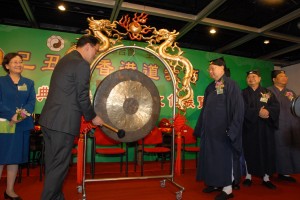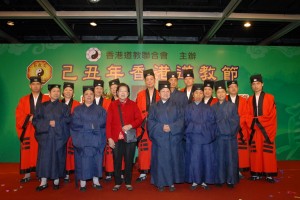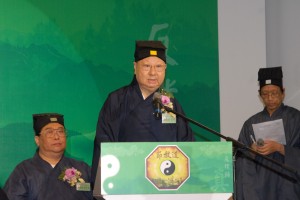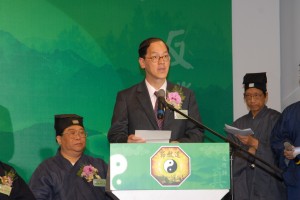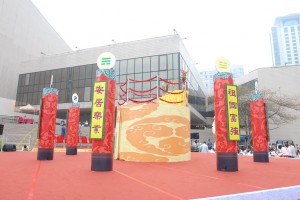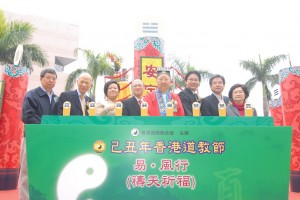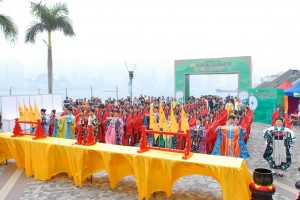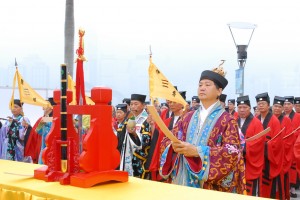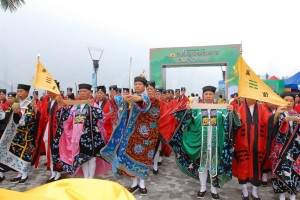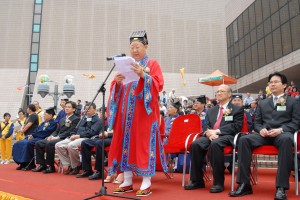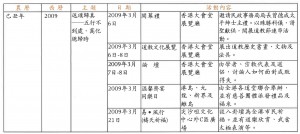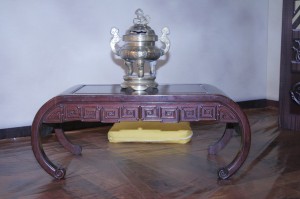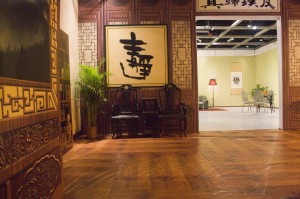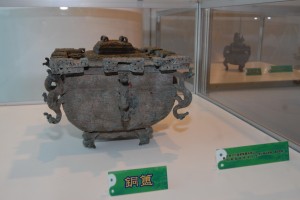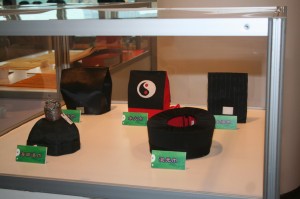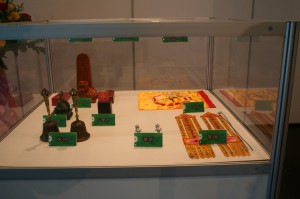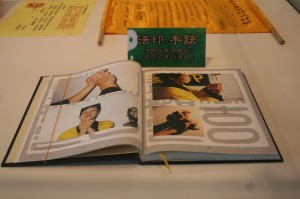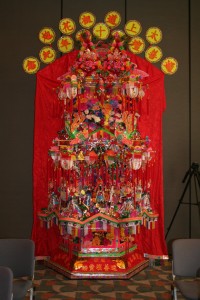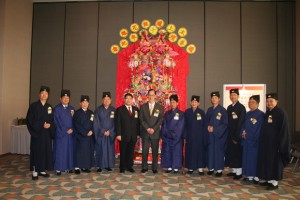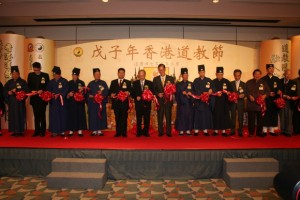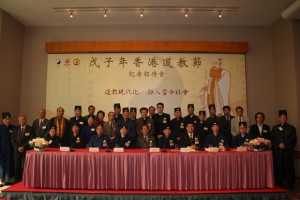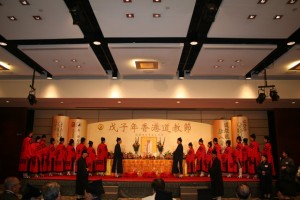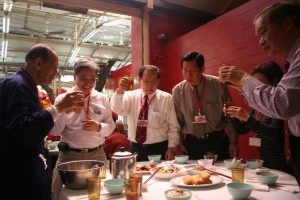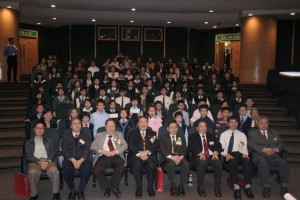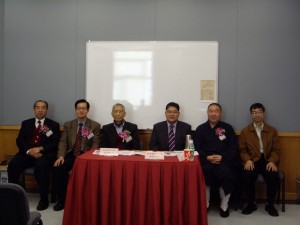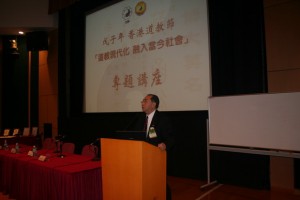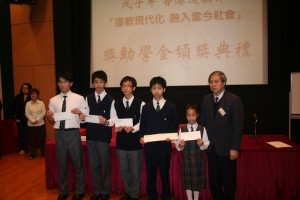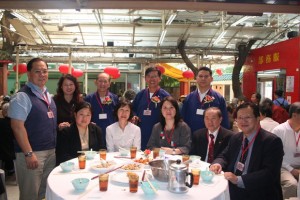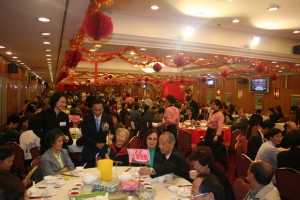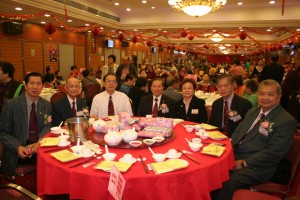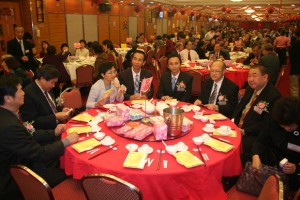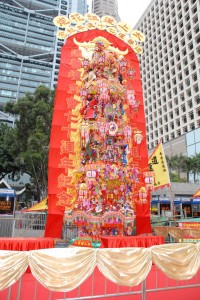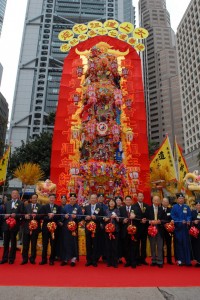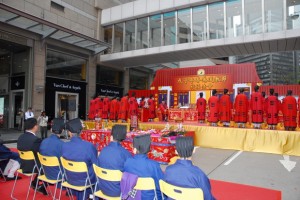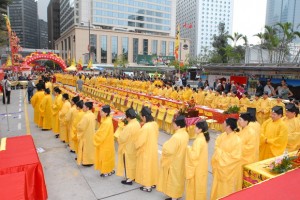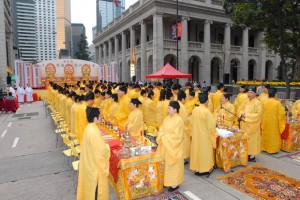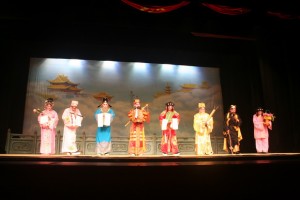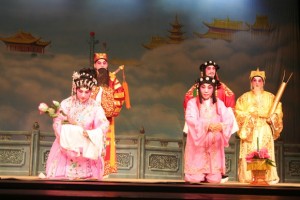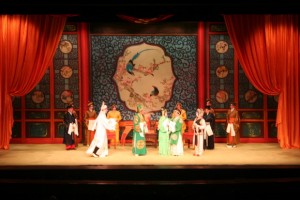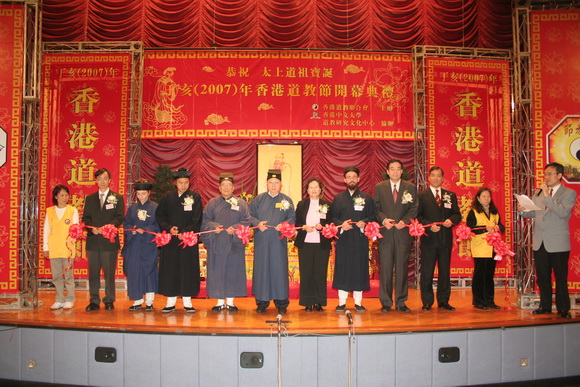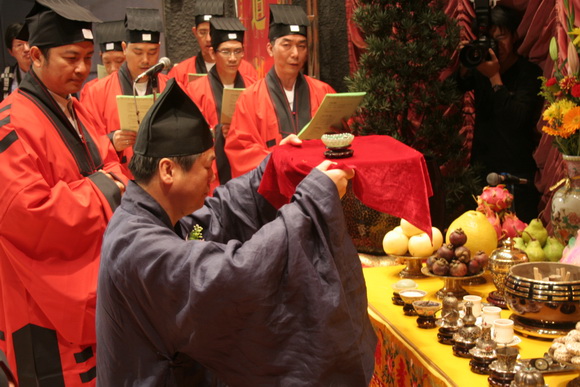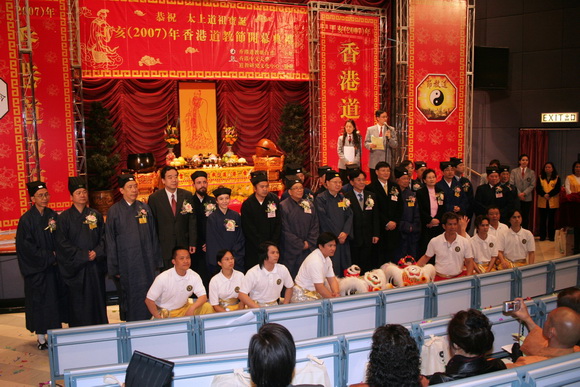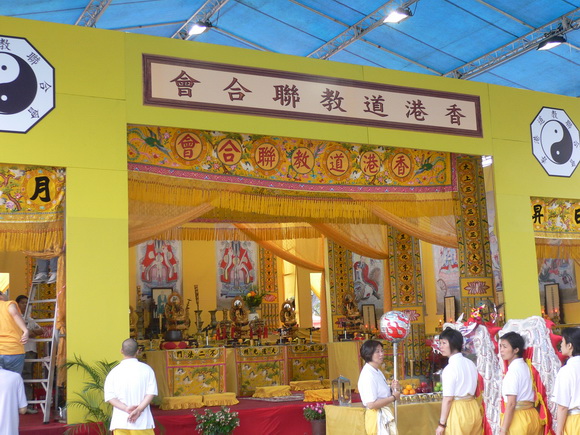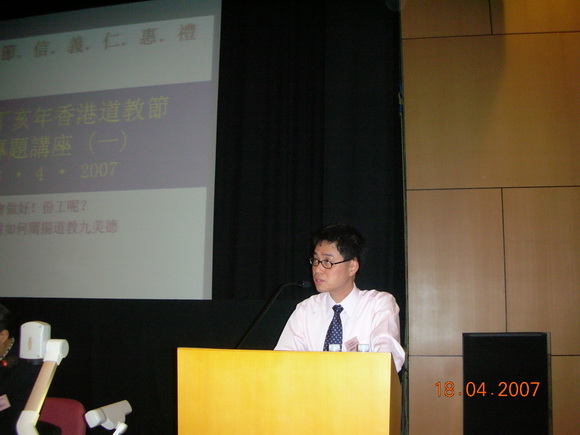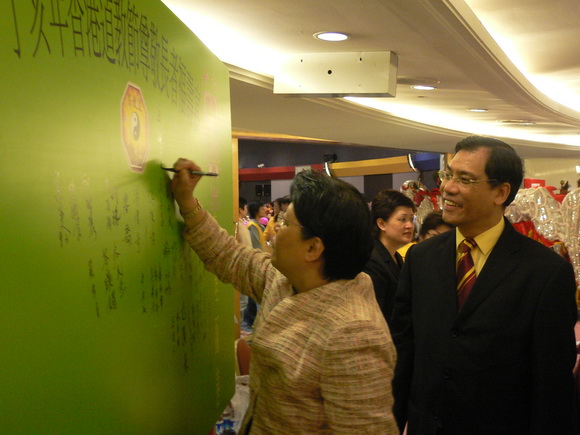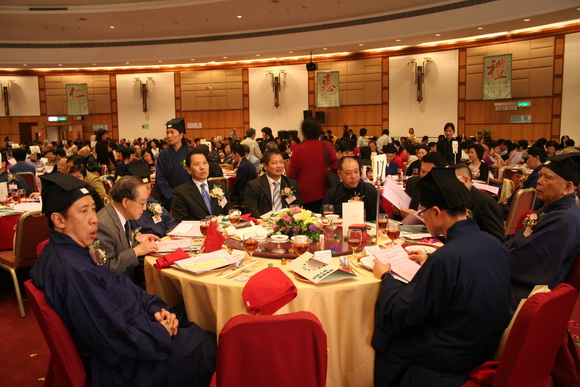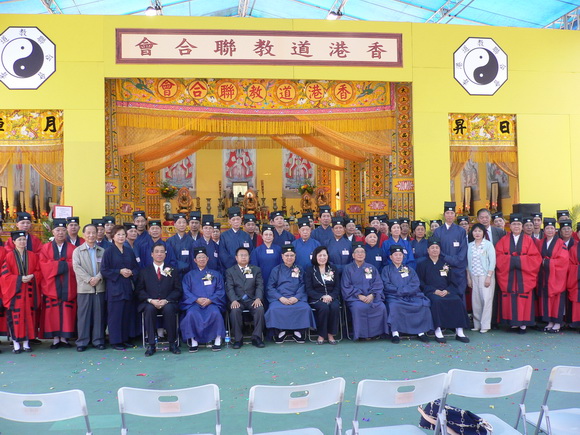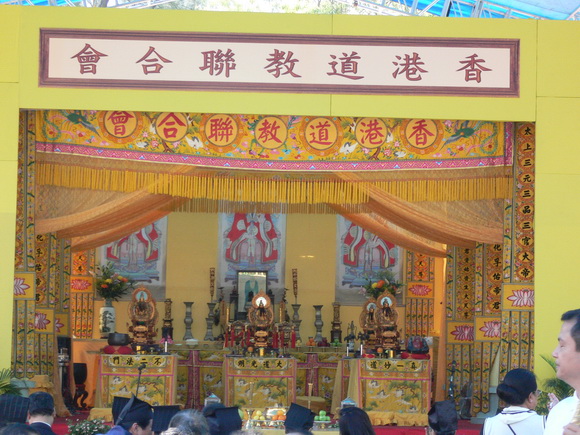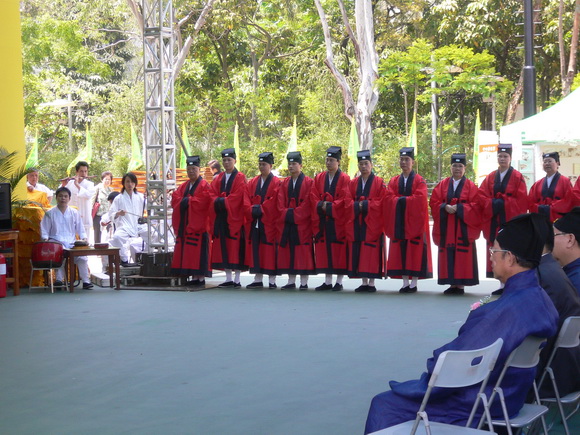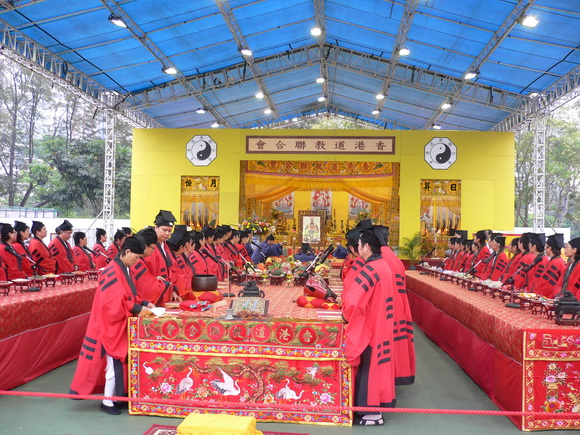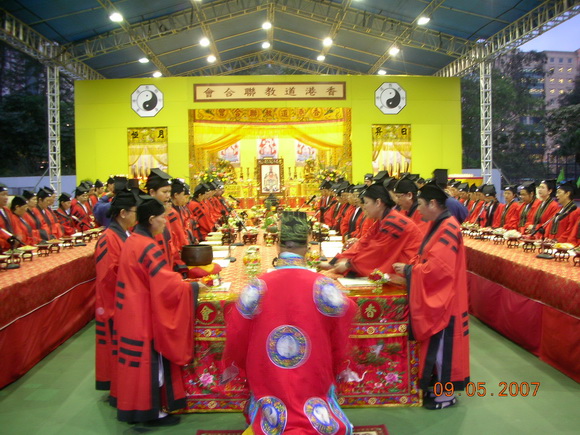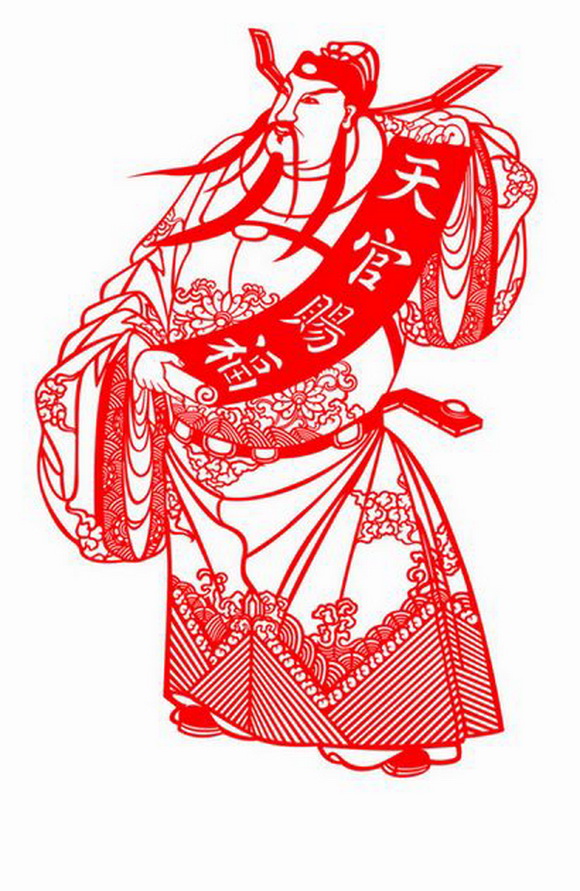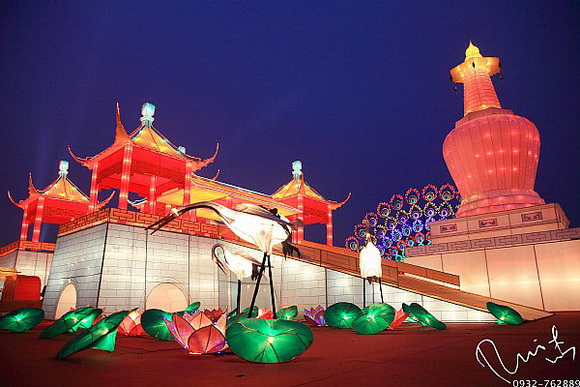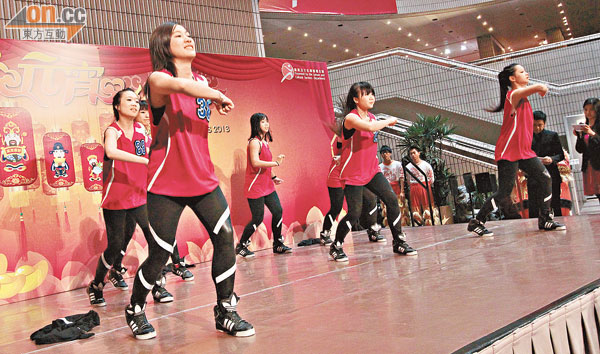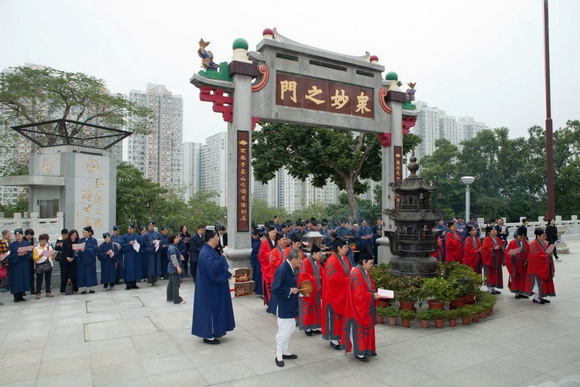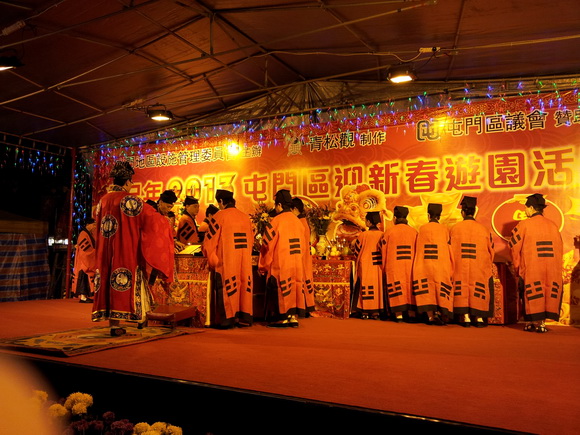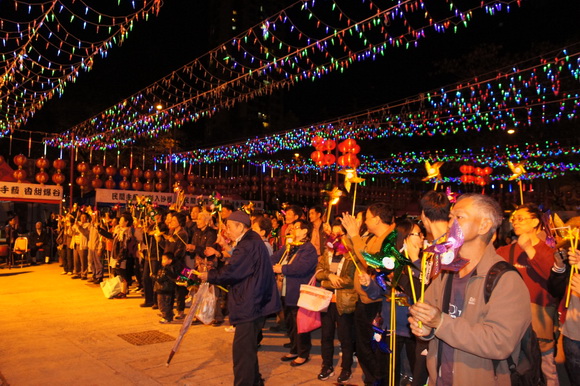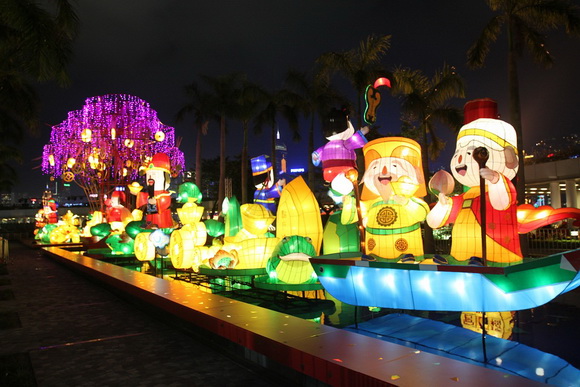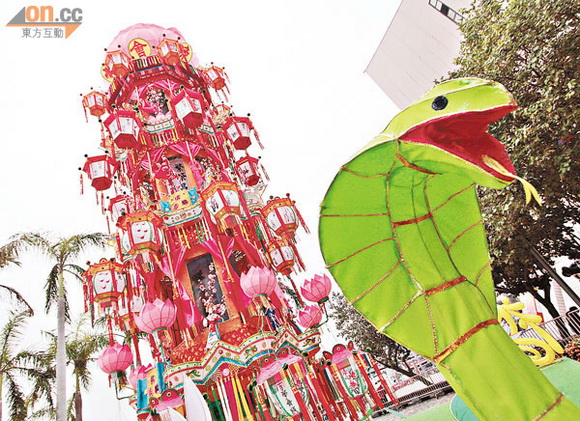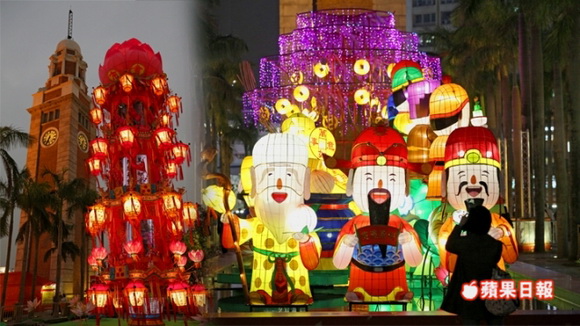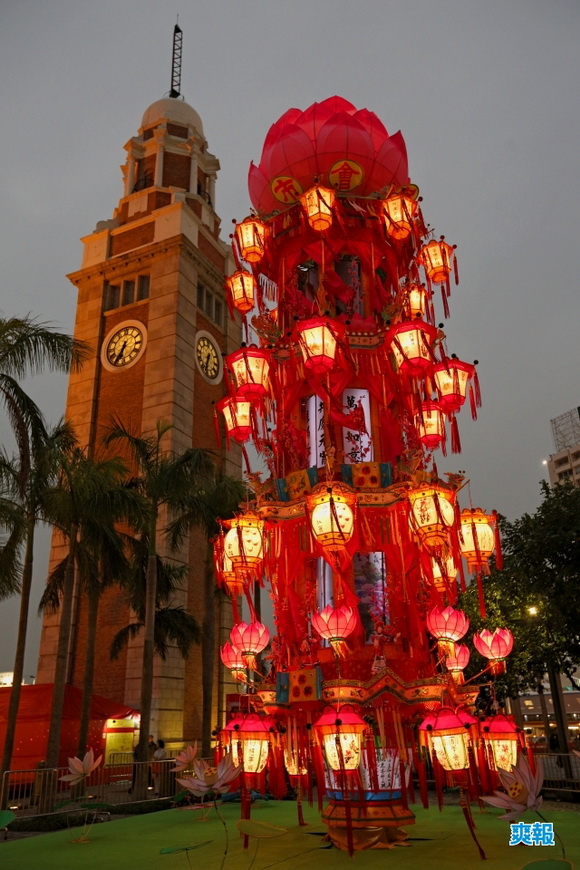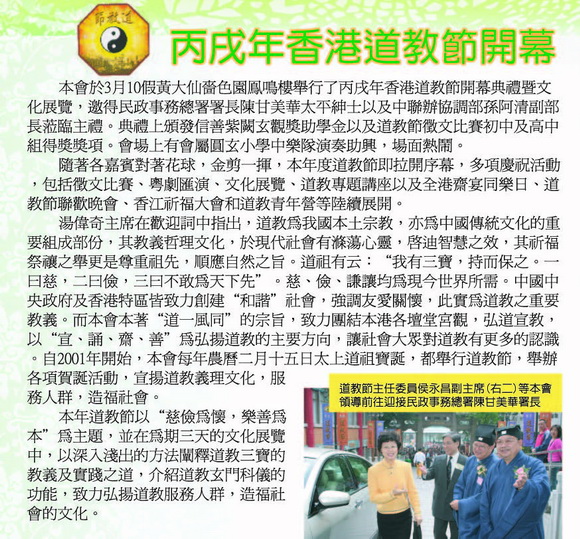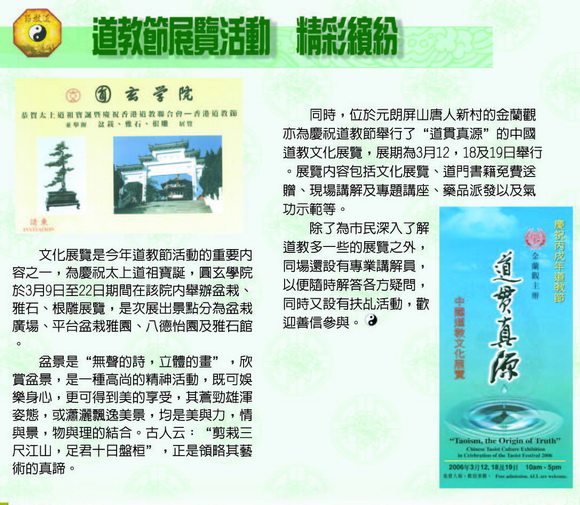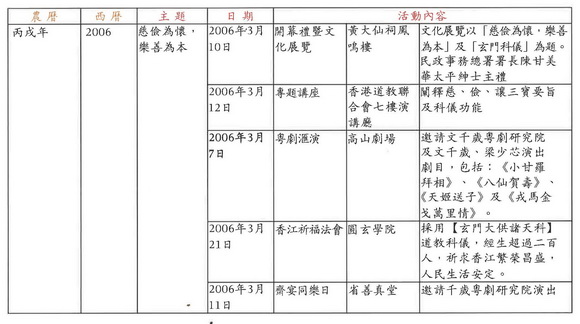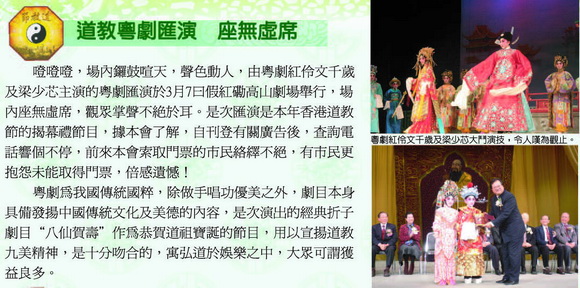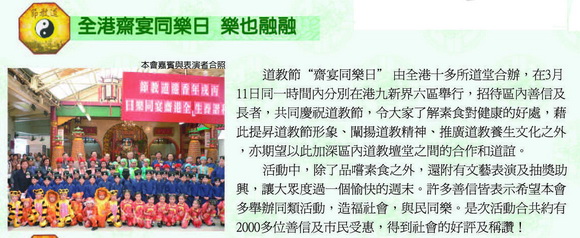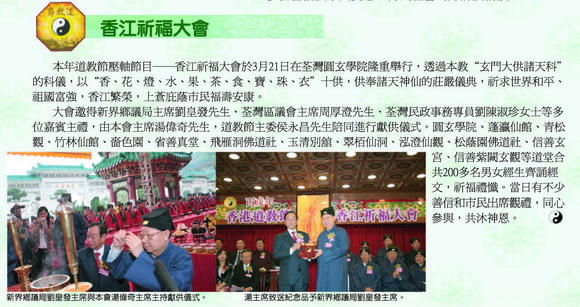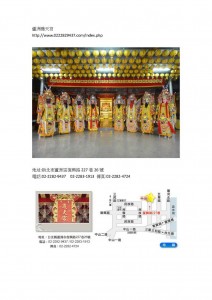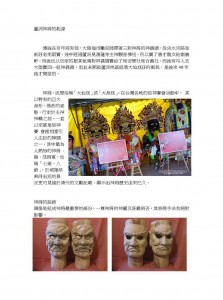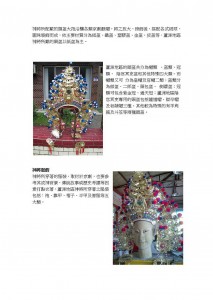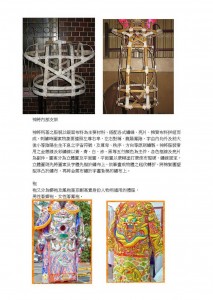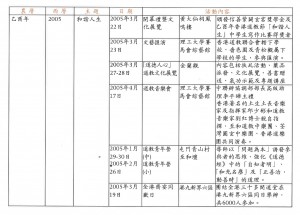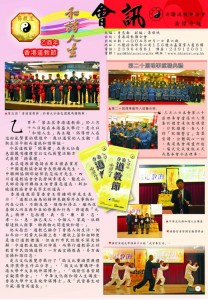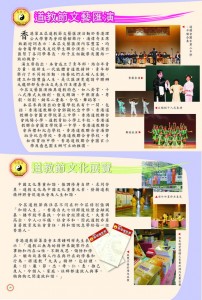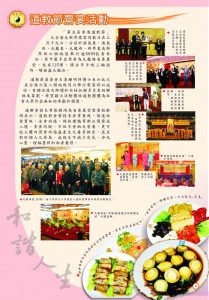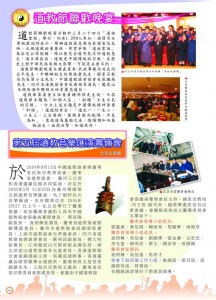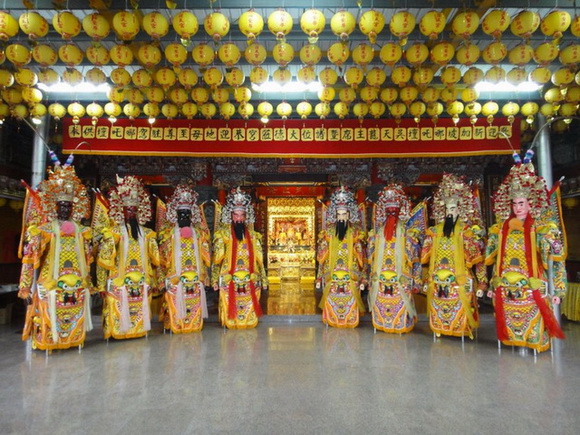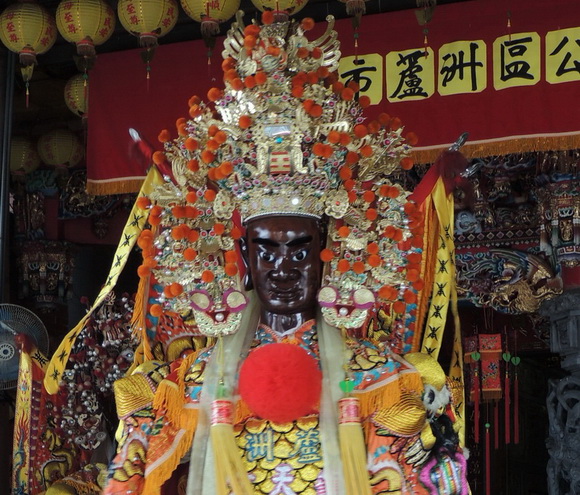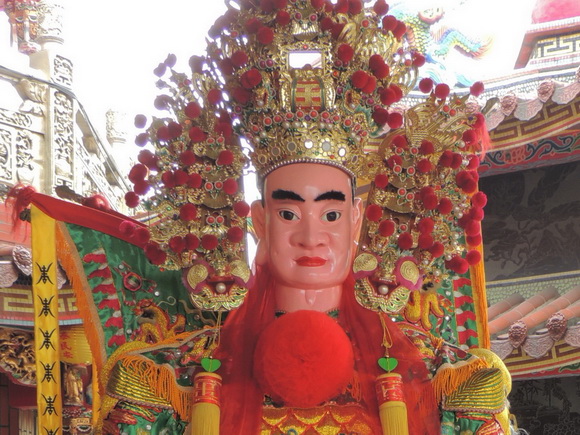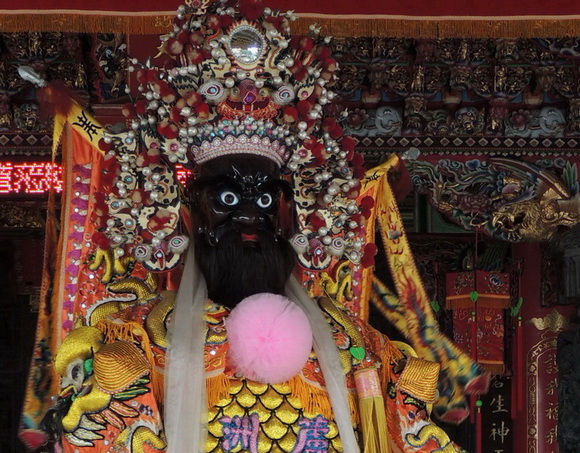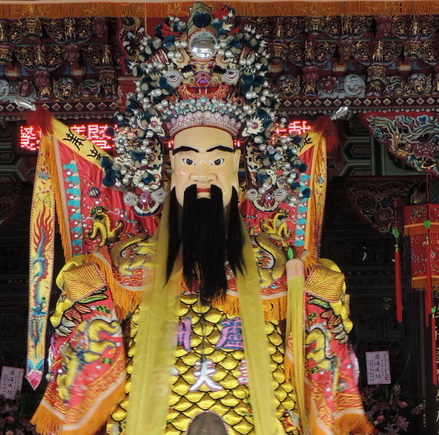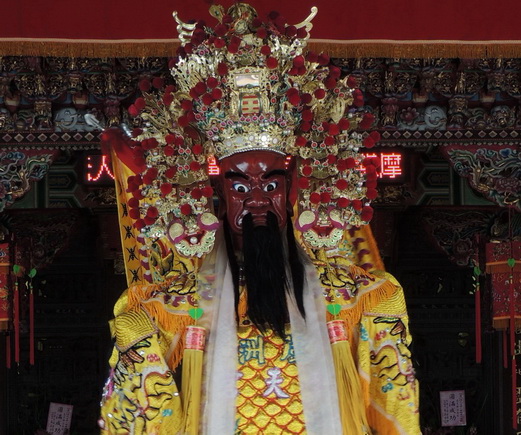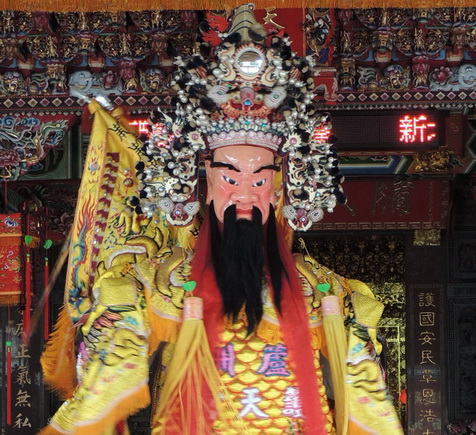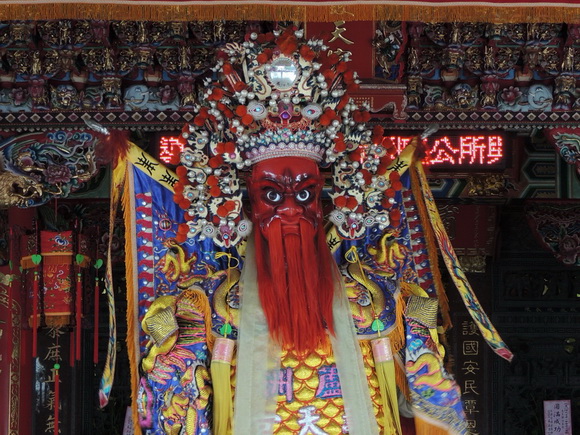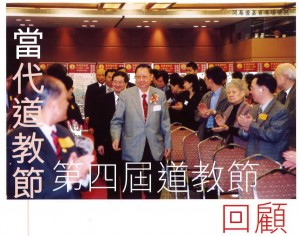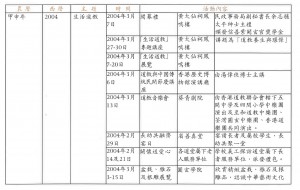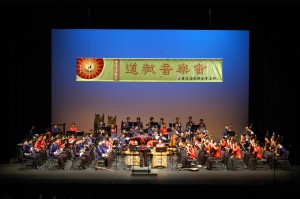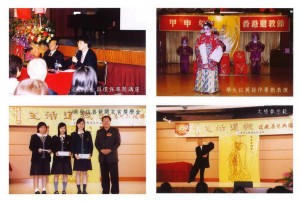-
第一屆至十二屆道教節花絮回顧 (9)
第九屆香港道教節
香港道教聯合會發起「香港道教節」已經踏入第九屆。鑒於丙戌年金融海嘯的波濤仍然洶湧,己丑年的天災人禍接踵而來,人心不安。承辦己丑年第九屆香港道教節活動的竹林仙館特地以「反璞歸真 —五行不到處,萬化總歸時」為主題,期望人心樸誠,社會經濟能回歸良性迴圈軌道。並以「易,風行」的活動作主旨。舉行禱天祈福、文化展覽、論壇、同樂日等多項活動,望使人能安靜,快樂生活,知道禮天奉道,祈福求祥。
第九屆香港道教節開幕禮
己丑年道教節開幕禮於2009年3月6日在香港大會堂低座隆重舉行開幕禮。中聯辦協調部部長高級助理李平曄、民政事務局局長曾德成蒞臨主禮,香港道教聯合會主席湯偉奇,副主席曾忠南、吳耀東、陳國超、黃漢瀚、侯永昌、梁德華,主任劉松飛,各位道長及宗教代表、各界嘉賓、同道逾200人出席,典禮上全場恭誦《太上道祖頌》,並由曾德成局長鳴鑼一響,揭開己丑年道教節序幕。
香道教聯合會主席湯偉奇爭取道祖寶誕為法定道教節日
香道教聯合會主席湯偉奇表示,該會主辦道教節已經踏入第9屆,活動獲社會人士廣泛認同,近10年香港道教界為國家和香港做了不少善事,包括賑災、扶貧、捐助希望小學、資助醫院和社會福利等,值明年香港道教節第10周年之慶,該會將編輯一本特刊,使社會各界更多地瞭解道教團體對社會的積極貢獻。湯偉奇還指出,目前全港有120萬道教信眾,該會已向當局提議將道祖寶誕日,即農曆2月15日列為法定道教節日。
民政事務局局長曾德成表示,道教提倡自然和諧、天人合一,其理念對個人修身養性、構建和諧社會、人與自然的關係都有啟迪作用。今屆道教節主題「反璞歸真」亦提示人們在金融危機中,要更加註重精神素養,解決矛盾。他感謝道教界多年推動道教文化的發展,以及在社會教育、醫療、福利方面的貢獻。對於設立道教公眾假期一事,他認為涉及政府多個部門的管理範疇,政府會審慎考慮,由於公眾假期的數目影響到經濟、勞工等問題,所以須審慎研究。
「易,風行」仿古法搭建祈福八卦玄壇
2009年3月21日在尖沙咀香港文化中心外 – C廣場舉行「禱天祈福」儀式。當日會場仿古法搭建祈福天壇,以玄門科範表達,象徵天人感應,福澤群生的意義。一面以簡要的方式為市民祈福亮燈,演繹中國古代的,另方面為世界和平,國家發展及本港繁榮而頌禱。
宗教界人士湯恩佳、黎時煖、高苕華、湯偉奇,嘉賓中聯辦九龍工作部部長高級助理葉萬權,油尖旺民政事務專員郭黃穎琦,油尖旺區議會主席鍾港武議員及華人廟宇委員會委員陳郁傑一同主持「亮燈」儀式。8人按下鈕掣,法壇上燈柱隨即亮起「世界和平」、「國泰民安」、「祖國富強」、「安居樂業」、「風調雨順」、「社會和諧」、「安定繁榮」、「政通人和」等祝福語。
81位道教高功,徐徐在道樂中步上3呎高玄壇,演繹中國古代的祭禮;期間湯偉奇主席在6呎高臺上,焚香上疏,祈求「天神父德俾四序之雨順風調,地祗母慈保萬物之物阜民安」。
香港道教聯合會主席湯偉奇,在6呎高臺上焚香「宣疏」,祈求風調雨順,物阜民安。湯偉奇說:「宣、誦、齋、善」,是傳統道教文化的信仰中心及實踐的主要方向,是日的「易、風行(禱天祈福)」活動,以及較早前第9屆香港道教節的一連串慶賀活動,也貫徹了這個重要的原則。
活動除了有金龍醒獅獻瑞助慶之外,會方在廣場中特設法壇,一方面向市民大眾展示道教科儀文化的獨特風貌,加深認識道教傳統文化;也希望為全港市民禱天祈福,祝禱香港全年順景,市民安居樂業,社會繁榮穩定。
道教文物展覽
-
第一屆至十二屆道教節花絮回顧 (8)
第八屆香港道教節
戊子年(2008) 第八屆香港道教節以「道教現代化,融入當今社會,共創和諧新世紀」為主題,除舉辦祈福法會、千叟宴和文化展覽外,更請到美國美田大學唐力權教授作專題演講,談「從一個新道家的觀點看中國哲學的特質」,主題引起共鳴。
今屆主題 - 道教現代化,融入當今社會,共創和諧新世紀
宗教組織多會隆重慶祝所信奉神祇的誕生日。香港道教界由 2001 年起,每年的太上道祖誕﹙ 農曆二月十五日 ﹚前後十天左右,均舉辦大型活動「道教節」,既以弟子的身分向道祖表達敬意,又能對內聯絡道誼、對外與民同樂,是集祭祀、宣道、祈福、行善、聯誼於一身的節慶活動。
過去的七屆「道教節」,均由本港的其中一間宮觀擔任統籌,2008年﹙戊子年﹚第八屆「道教節」由通善壇擔任統籌,當屆主題「道教現代化,融入當今社會,共創和諧新世紀」,表達出道教是中國本土宗教,亦為傳統文化的重要組成部份。其教義哲理於現代社會有滌蕩心靈、啟迪智慧之效。故希望以現代化的方法,令更多人重新認識道教。
第八屆香港道教節活動內容
1.「道教節開幕典禮暨記者招待會」
為更廣泛地散播道教節的消息,香港道教聯合會將聯同今屆統籌道堂 — 通善壇,與及上屆統籌道堂 — 飛雁洞佛道社,舉行開幕典禮暨記者招待會。承接過去七年的努力,希望本港同道繼續同心同德,務求令大眾進一步認識道教,繼而欣賞道教、信奉道教。過去一度僅流傳於宮觀道侶之間的學問,大會嘗試繼續運用現代化的宣傳策略、淺白親切的介紹手法,揭開其神秘面紗的一角。是次記者招待會亦將會向社會人士介紹「道教節」宗旨,昭示道教如何融入現代生活、道教界如何肩負締造和諧社會的責任。2.耆年樂聚千叟宴
去年道教節的「尊敬長者福壽宴」頗受好評,今年將再接再厲,擴而充之, 在全港分區域舉辦「耆年樂聚千叟宴」。這活動將會由香港道教聯合會團體會員在不同地區發揮影響力,接待該區街坊,同慶太上道祖誕。近年香港人均壽命持續上升,愈來愈多年逾古稀、老當益壯的長者。千叟宴既表揚長者對社會的貢獻、推廣敬老尊賢精神﹔也希望藉此宣揚道教養生文化,為長者享受身心健康晚年生活,提供一些有用的意見。3.「道教現代化,融入當今社會,共創和諧新世紀」專題研討會
如何將宗教生活融入當代社會,是所有宗教的重要課題。就著今屆道教節的主題「道教現代化,融入當今社會,共創和諧新世紀」舉辦講座,畫龍點睛, 探討在當代社會宣揚道教的方向,並 希望藉此加深大眾對道教文化的認識。4. 戊子年香港道教節專題講座﹕「從一個新道家的觀點看中國哲學的特質」
香港道教聯合會與香港教育學院宗教教育與心靈教育中心,邀請到美國美田大學的唐力權教授,蒞港作『專題講座』之主講嘉賓,專題講座,共分八講(。唐力權教授是美籍華人,早年負笈海外,活躍於學術界,訪問各地專上學府發表演講、主持講座之同時,亦發表多篇重要的論文。他主張的「場有哲學」,曾於海峽兩岸的學術界掀起熱潮。去年11月,香港道教聯合會請得唐教授出席「第四屆國際道教學術會議」,並致開幕演講﹔其後又到訪香港道教聯合會會屬中、小學,主持「道化教育」講座。5.「共慶同歡道祖誕」
是日係太上道祖誕正日, 大會將舉辦 聯歡晚宴,筵開齋宴上百席,讓全港宮觀同道聚首一堂,聯絡道誼,共賀道祖誕。6.「祈福法會暨道教文化展覽」
今年道教節亦將舉行祈福法會,而科儀則取《玄門大供諸天科》﹔祝願仙聖賜福,世界和平,國泰民安。同時又有道教文化展覽,向大眾展示道教文化的獨特風貌。7.道教節敬老粵劇匯演 — 高山劇場
今屆道教節請得鳴芝聲劇團,為大家獻上《八仙賀壽》和《花田八喜》兩齣精采劇目。道教與粵劇,同樣是中國文化的重要組成部份。這次表演既為博長者一粲,亦有宣揚中國文化之意。 -
第一屆至十二屆道教節花絮回顧 (7)
第七屆香港道教節
丁亥年第七屆道教節由飛雁洞佛道社統籌,以「德範九美、義理函善」為主題。2007年4月2日在中文大學邵逸夫書院大講堂舉行了一個別開生面的開幕典禮。來自中、英、法、港等國家和地區的道長向太上道祖老子上香,數百位道侶同聲禮送道曲,向老子致敬。
開幕典禮上,香港道教聯合會主席湯偉奇致詞時表示,香港市民過去大部分都不認識道教,對道教有負面的看法。經過六年舉辦道教節,香港市民逐漸明白道教,並開始用正面眼光看待道教。今年的活動包括尊敬長者福壽宴、文藝匯演、專題講座、道教文化展覽、祈福嘉年華。
本屆道教節主題為「德範九美、義理函善」,是指太上道祖老子在函谷關所著《道德經》,含天下至善之理,而奉行「孝、忠、廉、節、信、義、仁、惠、禮」九項美德,可達至高境界。
另外,在尖沙嘴文化中心與中央圖書館舉行道教文化文物展,展覽內容是香港道教聯合會特派專人到老子家鄉苦縣〈現今河南省鹿邑縣〉,拍攝老子出生地,牧牛場、講經台及老子母親墓地。此外,並得到國畫大師劉海粟首席入室弟子潘小嫻老師,繪畫了十幅老子降世以至升天的國畫。同時,得到四川鶴鳴山三聖宮複製張道陵天師石碑,此是「道教的第一塊石碑」。
「尊敬長者褔壽宴」,歡宴千多位長者,並請得立法會主席范徐麗泰女士聯同十八區區議會主席,致贈金牌予十八區長者,一同宣揚「眾善孝為先」精神。此外,樹仁大學的楊永漢教授亦發表演講,講解兩代相處之道。
當屆道教節最後一項重要活動,便是在5月8日至10日在維多利亞公園舉行祈福嘉年華,用道教科儀、道教音樂、文等展覽及攤位遊戲方式物,讓市民了解道教。
而當年道教界的活動還包括,四月二十一日至二十八日舉辦國際道德經論壇,在此前夕將有萬人在政府大球場齊聲誦讀《道德經》活動,創新紀錄。四月二十二日由國家宗教文化交流協會和中國道教協會主辦的《世界道德經論壇》。在老子傳經之地陝西樓觀台開幕,二十五日至二十七日在商貿繁榮的香港閉幕。此次兩地互動聯合舉辦活動,已受到國內領導人的高度重視,也引起社會各界的極大關注。《世界道德經論壇》的成功開展,必將使道教文化推向新的高潮。
-
道教與元宵節
道教與元宵節
元宵節( 正月半 ) – 正月十五是農曆新年的第一個月圓之夜,象徵著春天的到來。民俗文化中人們吃元宵、賞花燈、猜燈謎,以示祝賀。這是傳統新春定義的最後一天,亦是春節假期之後的第一個重要節日。中國明朝錢塘瞿佑《雙頭牡丹燈記》:「每歲元夕,於明州張燈五夜。傾城士女,皆得縱觀」。
每年的正月十五,既是民俗文化中的元宵節,又是道教文化中的上元節。道教文化與民俗文化相互融合,交匯出獨有的「過十五」文化。
農曆正月十五之所以稱為上元節,起源於道教的「三元說」。道教經義《雲笈七簽》中雲:「夫混沌分後,有天、地、水三元之氣,後成人倫,長養萬物。」
上元節與道教崇奉的神靈有關。道教是崇拜多神的宗教。道教崇奉的神靈種類繁多,其中三官大帝就是地位較高且較有影響者。三官大帝即天、地、水「三官」,有關其來歷說法頗多,或說起源於中國古代宗教對天、地、水的自然崇拜,或說起源於五行中金(主生)、土(主成)、水(主化)三氣,或以為即堯、舜、禹,等等。「三官」在早期道教中就已佔有很重要的地位,如漢末天師道為病人祈禱時需舉行「三官手書」儀式,即將病人姓名和服罪之意寫於紙上分別送呈天、地、水三官。
南北朝時期,「三官」又與「三元」相配而成為「上元天官紫微大帝」、「中元地官清虛大帝」、「下元水官洞陰大帝」。據稱,天官能賜福、地官能赦罪、水官能解厄,分別誕生於正月十五日、七月十五日、十月十五日。各地的人們為了祈福、拔罪和禳災,多分別在這三個日子舉辦「上元會」、「中元會」和「下元會」。
因此,道教將正月十五日定為上元節,七月十五日為中元節,十月十五日為下元節。
正月十五張燈的習俗,相沿已久。到了北魏,道教的上元節已經定型,上元張燈也由之固定下來。隋唐時代,元宵節張燈,達到十分興盛隆重,而且燈的品質不斷提高,娛樂活動日益豐富多采,並且一直沿襲至於近代。現代民眾的文化生活比以往豐富得多,但是對於傳統的節日仍然表現出很高的參與熱情。元宵節仍是民間的一個大節,而且它與宗教的聯繫已經淡化,而演變成全民性的時令節日。
元宵節以張燈觀燈為主要特點,同時舉辦豐富多彩的民間娛樂活。元宵節的活動最有吸引力的當然是張燈和觀燈。民間的藝人或者一般能紮燈的一般民眾,到了元宵前就要開始紮燈采。那燈,常常做成各種動物、花草,神仙,人物故事,戲劇造型等等。大家各起巧思,做出的花燈千姿百態,爭奇鬥妍。除了陳列為主的燈采之外,還有不少是以燈為道具進行表演的。比台舞龍燈,耍獅子燈,跑馬燈,等等,都是常見的民間演藝。
香港的道教宮觀大多會在正月十五日舉行祈福科儀,
如蓬瀛仙館舉行「上元寶懺」,「三元寶懺」及「東嶽懺」;
青松觀舉行「讚星行大運」等。
2013 香港元宵綵燈會一覽
財神到!多個卡通財神花燈紮作已於尖沙咀文化中心露天廣場駐場,祝大家財源滾滾,衣食無憂,一沾新春好意頭。而元宵佳節正日(2月24日),尖沙咀文化中心將有雲南大型民族歌舞表演,以及傳統手工藝包括汕頭瓶內畫、佛山剪紙、五華木偶、傳統花燈、粵劇化粧及劇服穿著示範。另外,香港文化博物館邀請本地紮作師傅,製作大型五層傳統走馬燈,屆時更有福、祿、壽三星、財神、運財童子將現身向你恭賀。
春節綵燈展 – 財源滾滾福運來
日期:2013年2月7日至3月17日
時間:6pm-11pm
地點: 香港文化中心露天廣場新界西元宵綵燈會
日期: 2013年2月22日
時間:7:30pm-10:30pm
地點:青衣公園新界東元宵綵燈會
日期:2013年2月23日
時間:7:30pm-10:30pm
地點:粉嶺遊樂場市區元宵綵燈會
日期:2013年2月24日
時間:7:30pm-10:30pm
地點:香港文化中心露天廣場( 文章內容及相片均來自網際網路)
-
第一屆至十二屆道教節花絮回顧 (6)
第六屆香港道教節
丙戌年第六屆道教節由信善玄宮統籌,以「慈儉為懷,樂善為本」為主題。2006年3月14日在黃大仙祠鳳鳴樓舉行開幕禮。
當屆道教節主題的意思是引自《道德經》所言:「一曰慈,二曰儉,三曰不敢為天下先」及「天道無親,常與善人」。慈、儉與為善,都是我們做人應有的德行。
道教節期間,以「慈儉為懷,樂善為本」及「玄門科儀」為主題。在黃大仙祠鳳鳴樓舉行道教文化展覽。
同時亦在香港道教聯合會會址舉行專題講座,闡釋慈、儉、讓三寶要旨及科儀功能為題,讓市民大眾對道教有更深入的了解。
本屆繼續主辦道教青年營、徵文比賽等,使年輕一代能體會道教教義真諦。
第六屆香港道教節在高山劇場舉行粵劇匯演,邀請千歲粵劇研究院演出多個精采劇目以饗坊眾。
以玄門科儀「玄門大供諸天科」祈求世界和平、祖國富強,香江繁榮,上蒼庇蔭市民福壽安康。
-
The relation between Taoist culture and it』s beliefs
Seminar atHuachiew Chalermprakiet University
Samut Prakan, ThailandBy Master Leung Tak WahIntroductionI would like to thank the Taoist Hwa Kwong Temple and the Taoist Hwa Kwong Athletic Association 6th Anniversary celebration organising committee and the Huachiew Chalermprakiet University for the opportunity to share at this seminar, but I have to admit I have mixed feelings.Thailand is a predominantly Buddhist country. As a Taoist disciple, I am happy and honoured to be able to share about my beliefs and Taoist culture in an important academic institution like the Huachiew Chalermprakiet University.I am practicing Taoism for over thirty years, and I am ordained as a thirty second generation disciple of the Quanzhen Dragon Gate tradition. I followed my father since young at the Fung Ying Seen Koon, and became the second generation disciple of the temple. I am currently serving as the Tutor of Rites for the Fung Ying Seen Koon. Taoist knowledge is so vast and deep, and I indeed feel nervous and stressed sharing in front of so many university students and academia. I would appreciate if you could highlight and share with me if you disagree with any of my sharing.Taoism is the only indigenous religion of the Chinese, and it encompassed the wisdom of the ethnic Chinese civillisation and its culture and traditions. This year is also the 4710th year of the Taoist calendar.It is really a challenge to share about the Taoist beliefs and culture in an hour, therefore, I will be giving you a brief introduction to two topics. First, I shall share with you the relationship between the Tao (道), Taoist school of thought (道家), and the Taoist religion (道教). Finally, I will also share with you the significance and values depicted in Taoist rituals.(1) Tao, Taoist culture, and Taoist religionThe character 「Tao」 (道) existed since ancient times, and it signifies the source of the Universe, and the evolution of all creations. This is the origin and source of the Taoist school of thought and the Taoist religion. There are six main schools of thought in ancient China as mentioned in the Records of the Grand Historian (史記) by Sima Qian. Taoism (道家) is one of the six schools, including Confucianism (儒家), Legalism (法家), Mohism (墨家), Logicians (名家), and the School of Yin and Yang (陰陽家). The Five Pecks of Rice tradition (五斗米道) was the first Taoist religious movement established by Zhang Daoling in the late years of the Eastern Han Dynasty, the movement comprised of twenty four dioceses.The Taoist school of thought and the Taoist religion complement one another and they are correlated. The Taoist school of thought is often regarded literally as 「philosophical Taoism」, and the Taoist religion is regarded as 「Religious Taoism」. The rituals and scriptures practiced in religious Taoism expressed many Taoist ideas and teachings, and these originated from the wisdom of the philosophers of the Taoist school of thought.I would like to cite the following example:The highest deities of the Taoist religion is the Three Pristine Ones, also known as 「San Qing Dao-zu」 (三清道祖).Presiding in the centre of the 「San Qing」 is the Primeval Lord of Heaven, or 「Yuan-shi Tian-zun」 (元始天尊), who held a round pearl in his hands, signifying the 「Qi」 (炁), or the Original vital breath of the Dao, which is the fundamental energy which existed even before the creation of Heavens and Earth. That is the known as the state of 「Wu-ji」 (無極).To the left of the 「Yuan-shi Tian-zun」 is 「Ling-bao Tian-zun」 (靈寶天尊), also known as the Heavely Lord of the Numinous Treasure. He held the Yin-yang mirror, which signifies the birth of the state of 「Tai-ji」 (太極) from 「Wu-ji」. On the right of 「Yuan-shi Tian-zun」 is 「Dao-de Tian-zun」 (道德天尊), or the Heavenly Lord of Dao and its Virtue, also known as 「Tai-shang Lao-jun」 (太上老君). He holds a fan, symbolizing 「liang-yi」 (兩儀), or the two energies which symbolized Heavens and Earth.The image of the Three Pristine Ones, or 「San Qin Dao-zu」, reflects the Taoist belief of 「From one vital breath forms San Qing, the state of 『Wu-ji』 evolved into 「Tai-ji」, and from 「Tai-ji」 it developed into 「liang-yi」, and from 「liang-yi」 froms all creations and things in the Universe. (一炁化三清,無極生太極,太極生兩儀,兩儀生萬物。) This also reflects the Taoist idea that 「Dao」 (道) embodies the Three Realms (三界) of Heavens (天), Earth (地), and Man (人), and 「Dao」 is the source and origin of all creations and objects.The Scripture of Peace and Tranquility (清靜經), Tai-shang Lao-jun (太上老君) expressed that 「The Great Dao has no form, yet it forms Heaven and Earth; The Great Dao is unbiased, it governs the changes in the universe and the patterns of the sun and the moon; The Great Dao seeks no acknowledgment, yet it nurtures and provide for all creations; I don』t know the name of this numinous energy, but I named it 「Dao」 to make reference to it.」 (大道無形,生育天地;大道無情,運行日月;大道無名,長養萬物;吾不知其名,強名約『道』。)The Taoist school of thought 「Dao-ji」, or philosophical Taoism, regards the 「Dao-de Jing」 (道德經) by Lao-zi (老子), 「Nan-hua Jing」 (南華經) by Zhuang-zi (莊子), 「Yin-fu Jing」 by the Yellow Emperor (黃帝), and other philosophical classics as the sacred texts. These scriptures are fundamental for Taoists to cultivate themselves to assist others (修己度人). Taoists believe that 「Tai-shang Lao-jun」 came to the mortal world as 「Lao-zi」, Zhuang-zi is styled 「Perfect Man Nan-hua」 (南華真人), and the Yellow Emperor is regarded as the ancestor of the Chinese people, and the ancestral patriarch of philosophical Taoism.Taoist religious beliefs of the immortals correlates to the philosophical teachings of Lao-zi. The Dao-de Jing mentions 「The creation of Heaven and Earth evolves to all other creations in the Universe, and this is the greatness of Dao」 (有物混成,先天地生,…強為之名曰大。). It also mentions that 「Dao creates One, One creates Two, Two creates Three, and Three generates all creations and things in the Universe」 (道生一,一生二,二生三,三生萬物。) Both verses explained that 「Dao」 is the state of 「Wu-ji」, One is the 「Tai-ji」, and Two is 「liang-yi」 (道是無極,一是太極,二是兩儀。), and it is a testament that Taoist philosophy and Taoist religion are both inter-related and both complementing each other.Both Philosophical and Religious Taoism believe that 「Dao」 is the fundamental belief. Taoists believe in the existence of the Three Realms – Heaven, Earth, and Man (天、地、人); and it includes the belief of the immortals and deities in the Heavenly Realm (天界), Spirits in the Earthly Realm (地界), and Man on the Mortal Realm (人界).How do Taoists view life and death? Taoists believe that birth and death is inevitable in all life forms (有生必有死). The exhibition of birth and death, fortune or misfortune, depends on the good actions and wrong doings of the individual. Taoists believe that one who is kind and compassionate will be blessed with longevity and good health, and those with evil intentions and harm others will be plagued with misfortune (善人得賜福長壽;惡人獲降禍厄困).Taoists believe in the heavenly deities and also the spirits. One who accumulates merits and does good will be able to attain the Dao, ascend the heavenly realms and free from all sufferings. Those who commit bad actions will be condemned to the netherworld and not be able to liberate from sufferings.(2) Taoist Rituals and Taoist PhilosophyTaoist RitualsTaoist Rituals are known as 「ke-yi」 (科儀), where 「ke」 (科) refers to the sacred scriptures, and 「yi」 (儀) refers to the ceremonies and etiquette of the liturgies. There are two main categoties for Taoist rituals, one for blessing the living (祈福), and another for the salvation of the dead from sufferings (度亡). The Taoist deities are also classified into Earlier Heaven Deities (先天神) and Latter Heaven Deities (後天神). Earlier Heavens Deities are formed by the vital breath of Dao, which includes the Three Pristine Ones (三清道祖), the Jade Emperor (昊天玉皇), the Five Venerable Sovereigns (五方五老), the Heavenly Lord of Supreme Oneness and Salvation from Misery (太乙救苦天尊), etcetera. The Latter Heaven Deities were once mortals who practiced and cultivated to attain immortality, people who contributed greatly towards mankind or the country, and were conferred as deities by the Emperors or by the common people. Latter Heaven Deities include Celestial Master Zhang Daoling (張道陵天師), Patriarch Lu Dongbin (呂祖師), the Goddess of Mercy 「Guan-yin」 (觀音大士), Lord Guan (關帝), etcetera.Taoists believe in the existence of the Three Realms, naturally, they will seek the blessings from the heavenly deities to bestow blessings, ward off misfortune, pray for longevity and good health. The Li-dou ritual (禮斗科儀) is one such example to pray for good luck and fortune. Salvation rituals for the dead (度亡科儀) will be conducted to seek the heavenly deities pardon their sins, advocate the proper teachings and counsel the spirits to do good and forgo evil, and also allow the spirits to repent and seek forgiveness for the wrongdoings they had committed, so they may be delivered from the sufferings.Regardless of blessing or salvation rituals, they encompassed different sets of etiquette and protocols,and different type of setups for the altars. For example in blessing rituals, the altar will be decorated in red colour, including the ceremonial robes of the priests which will also be red in colour. As for rituals for the dead, plain colour such as white or yellow will be used in the set up of the ritual altar and the priests will also be dressed in robes which are white or yellow in colours. Most importantly, all the scriptures and text used in the rituals include praising of the deities and immortals, reminders to do good and stay away from evil, repent and turn over a new leaf, and to express gratitude and repay kindness. It guides all to do good and serve others.Taoist PhilosophyTaoist scriptures such as the 「Dao-de Jing」 (道德經) and 「Yin-fu Jing」 (陰符經) expressed the ideas of the regulations and laws of nature and the universe (自然定律), relationship and interactions between the five elements (五行變化為哲理), and taught man to learn from history. Teachings such as 「wu-wei」 (無為) and not striving with others, using gentleness to overcome aggressiveness (以柔克剛), embracement and living together harmoniously (包容共存), the opposing relations between the five elements (五行生剋), changes and interactions between the Yin and the Yang (陰陽變化), and other ideologies to advise and inspire the practitioner. It allows mankind to understand and make sense of life and interactions in nature, cultivate oneself, unite the family, and also to govern the country. These ideas influence the beliefs of religious Taoism.SummaryI attempted to introduce the fundamental Taoist beliefs and the relationship between Philosophical Taoism and Religious Taoism in a simple manner, and hope you will pardon me for simplifying any ideas or teachings. I hope that we can have more oppurtunities to share our ideas and research into Taoist culture to achieve a harmonious society, and also world peace.Thank you. -
蘆洲護天宮及神將起源
蘆洲神將的起源
傳說在百年前有個,大陸福州雕刻師帶著三對神將的神偶頭,從淡水河路至新莊老街販賣,途中經過蘆洲見湧蓮寺主神觀音佛祖,所以賣了善才龍女給南義軒,而後也以依序的把其他兩對神偶頭賣給了和安樂社和合義社,而後有叫人去大陸賣回一組神偶頭,但並未開啟蘆洲地區組裝大仙尪仔的風氣,是後來40年後才開啟的。
“Shen Chiang” will be commonly called as ‘the immortal ‘s or ‘the big body ‘s among the people.Gods tour of inspection celebration of all parts of Taiwan has a match and will move about, it is with peculiar enormous figure, posture chinning up and chest, walk before the main supernatural sedan-chairs of spirit, has all guided one of one burst of heads that people fixed one’s eyes on about equally when will have a match to meet the god all the time. ‘General Xie and Fan’ that know very well among them, call ‘Gi Ye, Ba Ye’ too, the situation of the tour of inspection can see all documents in Ching Dynasty to record even more wh en city god holds a memorial ceremony for the allusion quatation, it is historical and long-standing to show and lost in thought.
Touching upon the “Shen Chiang” will originate from, can date back to Ching Dynasty the area of Fujian. Make an appointment and move it while cultivating Taiwan with coastal residents of Ching Dynasty in I arge batches, active in the area of Fujian, belong to the many folk faith of Volkswagen, transplantation Taiwan thereupon too, and within the definition of city god, the Eastern Mountain big emperors dark department believe in subordinate to a ministry spirit that be ar that system spread out, the moving in Taiwan of the reason too, after this, after over one hundred years of development, becoming Taiwan solemnly has characteristic burst of heads most. ( text from web )
-
第一屆至十二屆道教節花絮回顧 (5)
第五屆香港道教節
乙酉年第五屆道教節由省善真堂統籌,以「和諧人生」為主題,「道教 – 土生土長的宗教」為副題。2005年3月24日在黃大仙祠鳳鳴樓舉行開幕禮。
當屆道教節主題是倡導世人在這紛亂繁囂的環境中,應以道家的人生觀,求取生活平衡而達致和諧寧謐。
本屆亦首辦讓青年學子參與的道教青年營及文藝匯演,道教青年營活動旨在通過不同的歷史活動,滲以道教教理來散發青少年建立領導、溝通、解難及發展獨立自主性的能力和技巧。
其餘活動分別有:道教節齋宴,文化展覽及徵文比賽、文藝匯演、聯歡晚宴、道教音樂會及專題講座。
大型齋宴是由港九新界六區三十多座道堂首次於同日舉辦齋宴,宗旨是發揮道教「上善若水、水利萬物而不爭」的精神,更期望能藉此活動令市民得悉素食對身體的益處。
道教音樂會是由香港著名的音樂指揮家邱少彬,及道教音樂家劉紅博士親自指揮。而以「道教 – 土生土長的宗教」的道教專題講座,目的是透過講座令廣大市民能認識道教由黃帝,老子開始,歷數千年的綿長發展,以至今日的精神面貌。
-
參與道教日成立暨第13屆香港道教節的巡遊隊伍簡介 (1)
台北蘆洲護天宮地母廟八大神將
神將於城隍祭典時出巡的景況更可見諸於清代的文獻記載,顯示出神將歷史由來已久。台灣的蘆洲神將亦有百年歷史,在台灣各地的迎神賽會活動中,神將以其特有的巨大身形、昂然的姿態,行走於主神神轎之前,一直以來都是迎神賽會裡相當引人注目的陣頭之一。
即將舉行的道教日,香港道教聯合會迎請台北蘆洲護天宮地母廟八大神將參與道教日成立暨第13屆香港道教節的巡遊。這幾位神將早前走遍大江南北,蜚聲海外,深受海外人士認識,如今初來香港亮相,肯定受到矚目。
至於其他八神將分別是:
托塔天王:據《封神演義》,李靖是商朝末年陳塘關的總兵,育有三子,分別是金吒、木吒和哪吒。哪吒三太子鬧海,不慎殺死東海龍王之三子「龍王三太子」,李靖為息事寧人,逼哪吒三太子自殺,後又阻撓哪吒三太子以秘法復活。之後,哪吒三太子在太乙真人幫助之下,以蓮花化身成軀體,並找李靖復仇,李靖不敵,幸遇燃燈道人贈他按三十三天玲瓏寶塔,並將哪吒三太子困於該塔內,父子言歸於好。因此寶塔,李靖被稱為「托塔李天王」。後來,李靖助周武王、姜子牙討伐商紂,立有大功。功成名遂之後,退隱山林潛心修練,終於得道登天,位列仙班。
木吒:在《封神演義》中,木吒是陳塘關總兵托塔天王李靖的二兒子,兄長為金吒,弟為哪吒。木吒是九宮山白鶴洞普賢真人的弟子,曾下山助武王伐紂,擁有道術法寶「吳鉤寶劍」,有雌雄雙劍,下山首功便擊殺九龍島四聖之一的李興霸,後來在遊魂關亦曾斬殺徹地夫人立功。
金吒:曾出現在《西遊記》、《封神演義》等多部文學作品中。傳說金吒是陳塘關總兵托塔天王李靖的長子,有兩個弟弟,分別是木吒和哪吒。在《封神演義》中為文殊廣法天尊弟子,曾下山助武王伐紂。《西遊記》裡,金吒侍奉如來佛祖,做其前部護法。
茍元帥:《警世通言‧金令史美婢酬秀童》稱「原是天上,茍元帥塵緣已滿,眾將請他上天歸班,非擊死也。」也可以解釋為人的去世比如:在【清】洪升的《長生殿·情悔》寫到:「雖謝塵緣,難返仙庭。」
張元帥,字仲疇,河北定興縣人。中統初授御用局總管,改行軍總管。至元元年(1264)進順天路管民總管,次年移守大名,後進益都淄萊路行軍萬戶。以攻宋陷襄陽、下建康有軍功,改亳州萬戶,尋授鎮國上將軍、江東道宣慰使。至元十五年(1278),為蒙古漢軍都元帥攻宋,俘丞相文天祥;次年攻崖山,陸秀夫負宋帝昺蹈海死,宋亡。至元十七年(1280)病死,封淮陽王,諡獻武。
黃飛虎:《封神演義》中的人物,其妻遭到商紂王的調戲並被逼死,黃飛虎率部反叛殷商,逃出朝歌,投奔西歧的周武王。在姜子牙統領的伐紂戰役中,黃飛虎和他的兒子黃天爵、黃天祥、黃天祿、黃天化先後捐軀戰死。有說法黃飛虎的人物原型是姜尚,理由說法黃飛虎是姜子牙的演變脫化,姜子牙在唐朝時被封為「武成王」,與黃飛虎爵位同,而姜子牙號「飛熊」,又稱「飛虎」,應了黃飛虎的名字,所以黃飛虎應該是姜子牙的化身。
劉元帥:宮觀中有「五營座」,擺放於廟內壇桌上之側邊,或放於配祀神神龕內之側邊,也有單獨置於廟內主神旁神龕內或案桌上奉祀。劉天君,名後,東晉時人。生於岷江漁渡中,幼時落波心而不死。因貧,送於羅真人為侍讀,因精於五雷掌訣,能招風捉雨,隨叩即應,濟民助國。是年東京大旱,皇帝禱於劉天君祠,果有大雨。時秋大稔。皇帝敕命其為「立化慈濟真君」。玉皇大帝亦命劉天君職掌雷部王府的各種事務。
龐元帥:原名龐喬,字長清。據《三教源流搜神大全》,龐喬家境貧困,世為駕渡之工。但龐喬心行善良,對往來渡客無不平等,救人急難。玉皇大帝聞其至孝至誠,敕為混氣元帥,手執金刀,唯天門之出入是命,以降陰魔,除舊惡,秋毫不爽。
-
第一屆至十二屆道教節花絮回顧 (4)
第四屆香港道教節
甲申年第四屆道教節由嗇色園統籌,以「生活道教」為主題,2004年3月22日在黃大仙祠鳳鳴樓舉行開幕禮。當屆道教節以「生活道教」為主題,並透過主題展覽及「道教養生與環保」向市民大眾推廣道教文化教義。
另外,在葵青劇院舉行道教音樂會。由香港道教聯合會轄下五間中學及四間小學中樂團演出,及邀請至和道教中樂團、荃灣圓玄中樂團、香港道樂團等共同演出。
在道教節舉行前,大會舉辦了「關懷送愛心」活動,組織本會理事及會屬學校老師及同學探訪老人。及後及舉辦「長幼共融齋宴日」,宴請長者及屬校學生,長幼歡敘一堂,極具意義。
其他道堂也分別舉辦各種慶賀,如盆栽展、道學講座等,以配合本屆道教節的主題。
